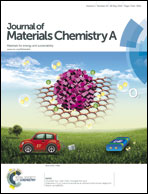Micelle templated NiO hollow nanospheres as anode materials in lithium ion batteries†
Abstract
Nano-sized nickel oxide (NiO) hollow spheres of size 28 ± 2 nm have been synthesized by a soft-template self-assembly process. ABC triblock copolymeric micelles of poly(styrene-b-acrylic acid-b-ethylene oxide) (PS–PAA–PEO) with core–shell–corona architecture serve as an efficient colloidal-template for fabrication of NiO hollow nanospheres. In the above polymeric template, the PS block (core) acts as a template of hollow void space, the PAA block (shell) with negative charges serves as the reaction site for metal ion interactions, and the corona domain stabilizes organic/inorganic composite particles. The PS–PAA–PEO template micelles as well as the NiO hollow nanospheres were thoroughly characterized by dynamic light scattering (DLS), transmission electron microscopy (TEM), X-ray diffraction (XRD), thermal analysis (TG/DTA), FTIR spectroscopy, and nitrogen adsorption/desorption analyses. The XRD and TEM techniques confirmed the hollow spherical morphology and phase purity of nickel oxide nanoparticles. The NiO hollow nanospheres were further investigated as anode materials for lithium ion rechargeable batteries for the first time. The nanostructured electrode delivers a high capacity of 393 mA h g−1 after 50 cycles of charge–discharge at a rate of 0.3 C. More importantly, the hollow spherical electrode maintains the structural integrity and excellent cycling stability even after subjecting to a high rate of 10 C (high current density). The high electrochemical performance is attributed to hollow void space coupled with a nanosized NiO shell domain that facilitates fast lithium diffusion kinetics.


 Please wait while we load your content...
Please wait while we load your content...